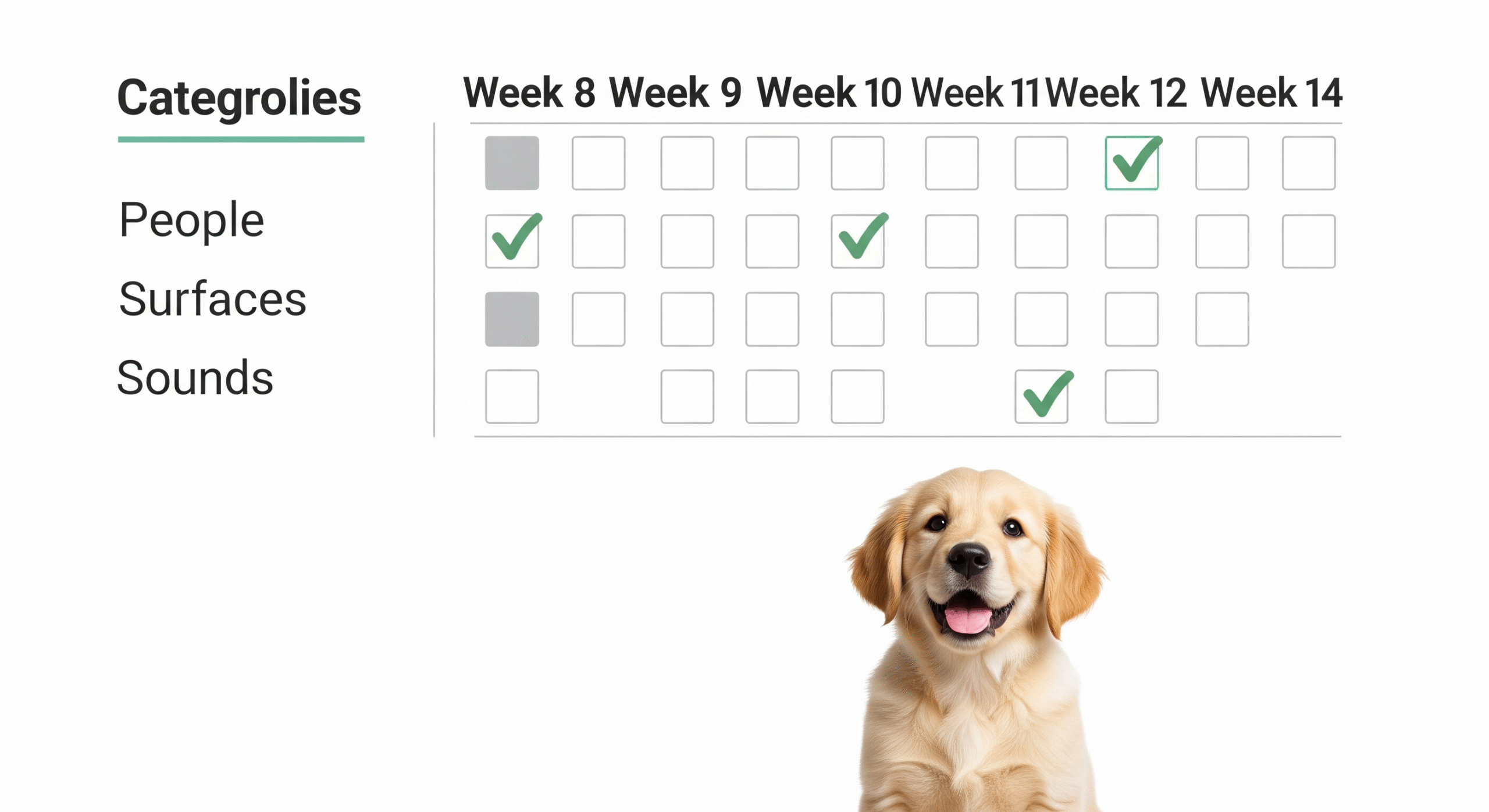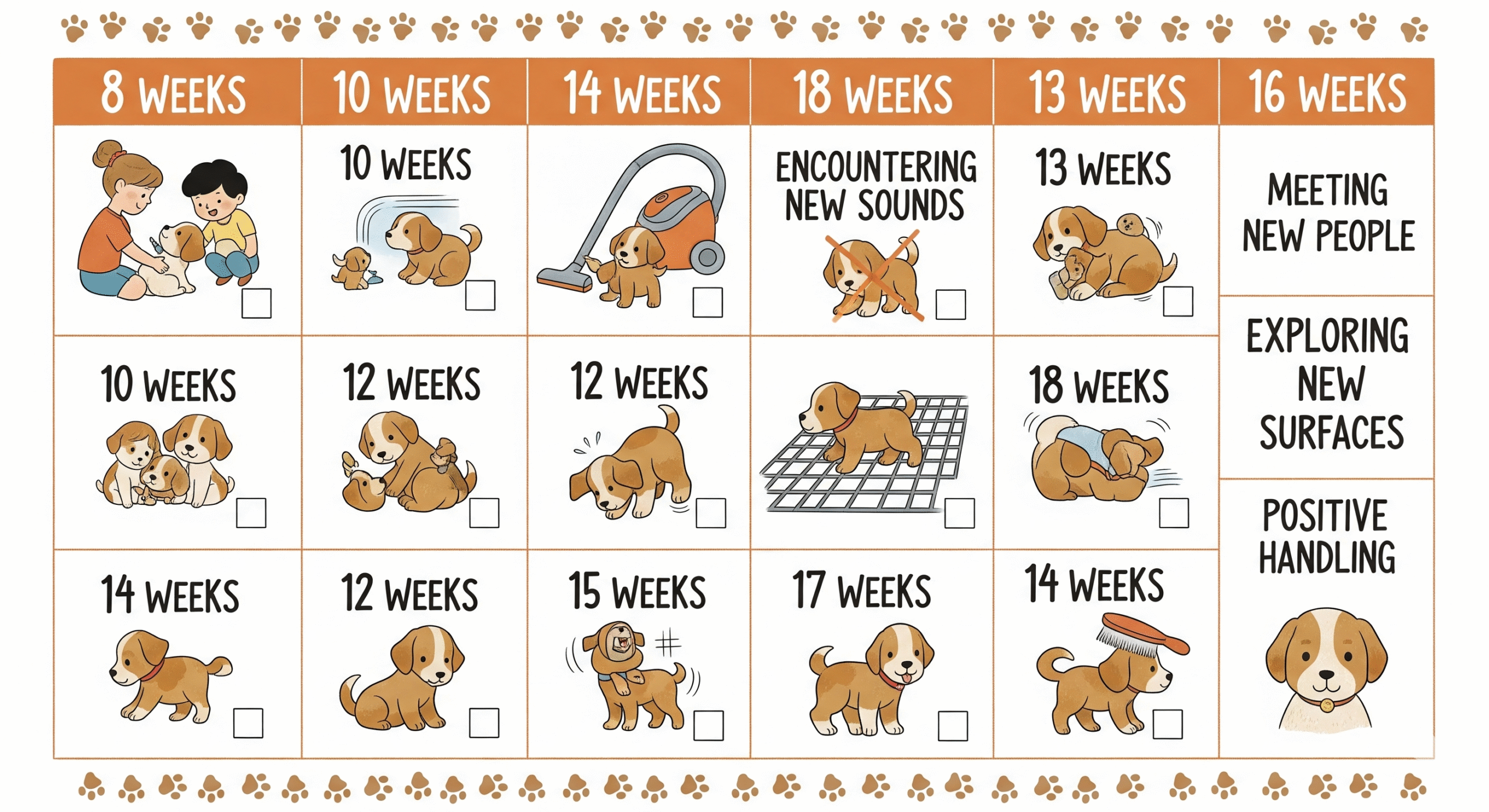The first few months of your puppy’s life are the most influential for their future behavior. Proper socialization isn’t just about meeting other dogs; it’s about carefully and positively exposing your puppy to the vast human world to ensure they grow into a confident, stable, and friendly adult dog. Missing this narrow window can lead to fear, anxiety, and aggression down the road.
This isn’t a casual to-do list—it’s a strategic plan. This comprehensive puppy socialization checklist breaks down essential experiences by age, ensuring you introduce the right stimuli at the right time.
Here’s what you’ll find inside:
✔️ Why socialization is a non-negotiable part of responsible puppy ownership
✔️ A week-by-week checklist from 8 to 16 weeks old
✔️ How to socialize safely before vaccinations are complete
✔️ What to do if you miss the prime window
✔️ Printable checklist to track your progress
Let’s build an unshakable foundation for your dog’s lifelong confidence.
Why Socialization is More Than Just Playdates 🌍
Socialization is the process of preparing a dog to enjoy interactions and be comfortable with other animals, people, environments, and experiences. The primary socialization window for puppies is between 3 and 14-16 weeks of age. During this time, their brains are exceptionally receptive to new experiences.
Puppies who are well-socialized are:
- Less likely to develop behavior problems like fear and aggression.
- Easier to train and manage in public settings.
- More resilient when faced with unexpected changes or stress.
- Overall, happier and safer companions.
The goal is to create positive associations. We’re not just exposing the puppy to new things; we’re making sure those experiences are fun and rewarding.
How to Socialize Safely Before Full Vaccination 🛡️
The biggest challenge is that the prime socialization window closes around 16 weeks, but puppies aren’t fully vaccinated until about 16-18 weeks. This does not mean you should keep your puppy locked inside.
Safe socialization means being smart, not avoidant:
- Avoid high-risk areas like dog parks, pet store floors, and public parks where unknown dogs frequent.
- Carry your puppy in busy areas or use a stroller or wagon.
- Host playdates with known, vaccinated, and puppy-friendly dogs in your own sanitized yard.
- Use your car as a socialization tool. Park outside a school and let your puppy watch children play from the safety of the car.
The Ultimate Puppy Socialization Checklist by Age 📋
Aim to check off several items from each category every week. Always keep experiences positive and end on a high note.
Weeks 8-10: The Home Base 🏠
- People: [ ] Men with beards/hats/sunglasses [ ] Children (supervised) [ ] People of different ages & sizes
- Handling: [ ] Touch paws, ears, mouth, tail [ ] Practice wearing a collar/harness [ ] Introduce a gentle brush
- Surfaces: [ ] Carpet [ ] Tile [ ] Wood floors [ ] Grass [ ] Concrete [ ] A wet towel on the floor
- Sounds (play at low volume): [ ] TV/Radio sounds [ ] Vacuum cleaner (in another room) [ ] Doorbell [ ] Kitchen noises (blender, microwave)
Weeks 10-12: Expanding the World 🚗
- Environments: [ ] Friend’s house (with vaccinated dogs) [ ] Car rides [ ] Park (while being carried) [ ] Quiet parking lot
- Sounds: [ ] Traffic noise [ ] Sirens in the distance [ ] Kids playing [ ] Thunderstorms (use a recording)
- Objects: [ ] Umbrellas [ ] Shopping bags [ ] Brooms/Mops [ ] Wheeled objects (bikes, skateboards at a distance)
- Novelty: [ ] Walk on a leash in your yard [ ] Eat from a puzzle toy [ ] See a person in a wheelchair or using a walker
Weeks 12-16: Building Confidence 🏆
- Environments: [ ] Outdoor cafe (on a blanket) [ ] Vet office (just for happy visits and treats!) [ ] Train station (watch from afar)
- Animals: [ ] Calm, vaccinated adult dogs [ ] Puppies of similar size/vaccination status [ ] Cats (if applicable, supervised)
- Procedures: [ ] Practice being on a grooming table [ ] Simulate a vet exam (touch everywhere) [ ] Wear a doggy raincoat or booties
- Advanced: [ ] Walk on a metal grate [ ] Navigate a wobbly surface (like a low plank) [ ] Go through a tunnel (play tunnel for kids)
What to Do During Socialization Sessions 🎯
- Let the Puppy Choose: Use the ” consent test.” Let the puppy approach new things in their own time. Don’t force them.
- Pair with High-Value Treats: The moment your puppy notices something new (a loud truck, a person in a hat), give them an amazing treat (chicken, cheese). They will learn new things predict good stuff.
- Watch Body Language: Signs of stress include yawning, lip licking, tucked tail, and hiding. If you see these, create more distance from the stimulus and make the treats even better.
- Keep it Short & Sweet: Five to ten minutes of positive exposure is better than an hour of overwhelm.
What If You Missed the Early Window? 😥
It’s never too late to socialize a dog, but it requires more patience.
- The Process is the Same: Use distance and high-value treats to create positive associations.
- Go Slower: An adolescent or adult dog will need more time to process new things.
- Manage Expectations: You may be working on helping them tolerate something rather than love it.
- Seek Professional Help: For dogs showing fear or aggression, a certified force-free trainer or behaviorist is essential.
Final Tips for Socialization Success 🌟
✅ Start the day you bring your puppy home.
✅ Quality over quantity. One positive experience is worth ten rushed ones.
✅ If you can, prioritize socialization over other training in the first month.
✅ Always set your puppy up for success. Control the environment to ensure positive outcomes.

If your once-bold puppy has suddenly become nervous about everyday objects, sounds, or people, this might not be a training setback. Puppies go through predictable developmental stages where they become more sensitive to their environment. This is likely a normal ‘fear period,’ and understanding it is key to helping your pup through it. For a complete breakdown of when to expect these phases, how long they last, and exactly how to respond, our guide on Puppy Fear Periods: What to Expect will provide the clarity and reassurance you need.






